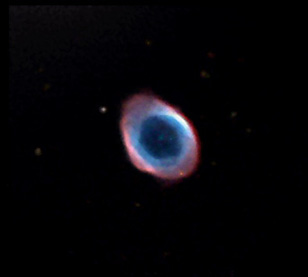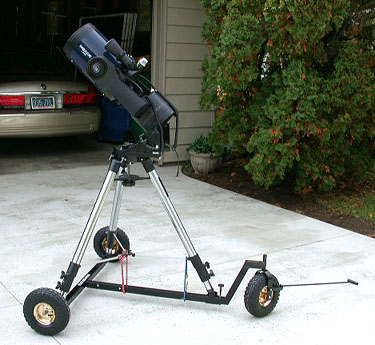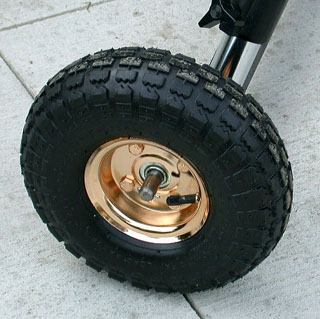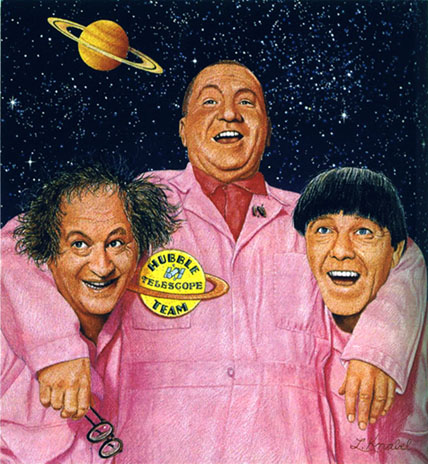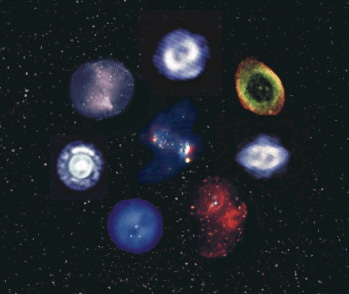 ©2006 Richard MurrayThe picture above is a collage of images I have taken over
©2006 Richard MurrayThe picture above is a collage of images I have taken over
the past year with my LX90 telescope and modified webcams.Sir Fred Hoyle, was an eminent astronomer and author of numerous books on science and cosmology, who decided to take a detour in 1957 and write a science fiction novel he referred to as his "frolic" called, 'The Black Cloud'. I still have the 1959 paperback edition of that book. The story unfolds as a young grad student by the name of Knut Jensen is searching for supernova using a blink comparator. He suddenly discovered in a rich star field a large, almost exactly circular, dark patch. Further scientific analysis revealed that this cloud was moving directly toward the sun, and that it appeared to be controled by some form of intelligence! Scientists puzzled over how an intelligent entity could control an enormous gaseous nebula, and decided that it must be done through the manipulation of magnetic fields within the cloud of gas:
"I imagine that the beast orders the material of the cloud magnetically, that by means of magnetic fields he can move materials wherever he wants inside the cloud."
Here's an image of the paperback edition below.
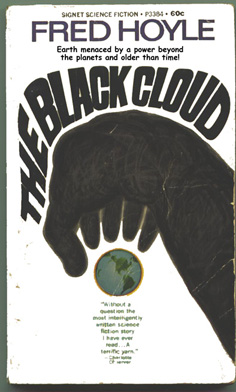
If you're wondering why this journal entry about planetary nebulae begins with a reference to a science fiction novel read on . . . . . . .
Planetary Nebula - fascinating objects to view and photograph, they come in all shapes and sizes: shells, rings, butterflies, bowties and hoursglasses. How they come about is no mystery. The real question puzzling scientists is why they take on such radically different shapes. But first let's take a brief look at the question of how they come about. Here is a quote from my earlier Journal entry on M76, The Little Dumbell [
M76 The Little Dumbell ]:
"For the most part, the type of nebulae that I have been imaging are planetary nebula. The first ingredient necessary to form one of these unique objects is a sun about the size of our own but no more than eight solar masses. After several billions of years, when most of the hydrogen has been burned, the core will contract, the temperature will rise and the star will become much larger and redder. Once the helium in the core ignites and becomes exhausted, the star begins to shed its gaseous envelope and enters a super red giant phase with most of the stars inner planets burnt and stripped of their atmospheres (nice thought huh?). Over thousands of years, the stars gas is shed even further through a process of stellar winds and 'helium shell flashes' (don't ask) to eventually form a planetary nebula. What shape this will take is anybody's guess which is part of the fascination in viewing and imaging these interesting objects. After 50,000 years or so the nebula will begin to dissipate into space leaving behind the stars old core which will transform into a white dwarf."
At least 95% of the stars we see in our own galaxy, the Milky Way, will share this same fate while the other 5% will literally blow up with a massive universe wide flash to become supernova. The total amount of matter returned to the interstellar medium by all the planetary nebulae in the galaxy is about 5 solar masses per year, which amounts to perhaps 15 percent of all the matter expelled by all sorts of stars. Planetary nebulae therefore play a significant role in the evolution of the whole galaxy.
Now on to why each planetary nebula shape is so distinctive. First of all, age and size: these nebula are mere infants on a cosmological time scale. Once the gaseous envelope is present their average age is about 10,000 years and they are typically 0.5 parsecs in diameter. A parsec is defined as the distance light travels in 3.26 years or 206,000 times the distance between our Sun and Earth. So the age of the nebula when it finally becomes visible to us determines, in part, its shape. A second factor is the nebulas orientation to our point of view. At one point it was therorized that all planetary nebulae have the same basic spheroid shape to begin with, its just the direction they face toward us that determines how we perceive there shape to be. This is partly true but by no means tells the whole story.
Around 1995 it was determined by Susan Trammell from University of Texas McDonald Observatory ,through an indirect observational method called optical spectropolarimetry, that whether a planetary nebula was to take on a spherical or asymmetric (non spherical) shape was determined at a very early stage of the nebula's development; so early, in fact, that they are not even optically visible to us. But that still doesn't explain what factors determine the shape. For example, what type of physical force could cause this NASA Hubble image of the mZ3 or Ant Nebula to be this dizzyingly complex!
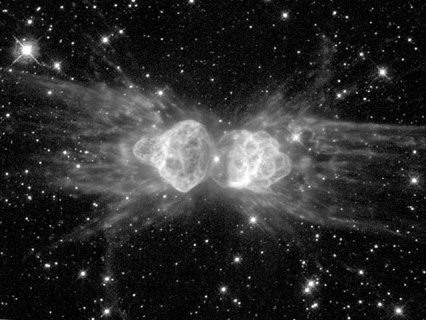
Just look at all the loops, vortexes, filaments and bubbles that make up this thing. It really makes you just stand in awe and able to do nothing much beyond scratching your head.
But then some astrophysicists and magnetic field experts at the University of Rochester (after scratching their heads) just might have come up with most of the answers to the complex shape dilemma. The idea that speed of star rotation and the resulting magnetic fields influence the shape of gaseous nebula is nothing new. It was first discovered by the 1902 Nobel Prizewinner, Pieter Zeeman, that the degree of polarization of light emitted by a star is directly influenced by the strength of the stars magnetic field. The Rochester scientists theorized that as matter blows off a dying star it loops and twists around the stars magnetic field lines thus forming the contorted shapes we see. This would be a very plausible theory except for one thing. The central stars of planetary nebula are very old and as such are not supposed to have very strong magnetic fields. You can't have the kinds of complex shapes we see around a star whose rotation is slowing down resulting in a feeble magnetic field. But what would happen if ,as the central star started its expansion and its rotation started to slow down, its inner core shrunk and started to spin faster and faster? What you would have then is a phenomenon known as differential rotation; the inside rotating fast, the outside rotating slow. This is exactly what the Rochester groups computer models supported which results in a star with a very strong magnetic field; strong enough to be up to 100 times the magnetic field of our own sun!
Now we have a good theory but we still need proof. Take a look at this stunning combination Hubble visible light and Chandra Xray image of the Cats Eye Nebula courtesy of NASA.
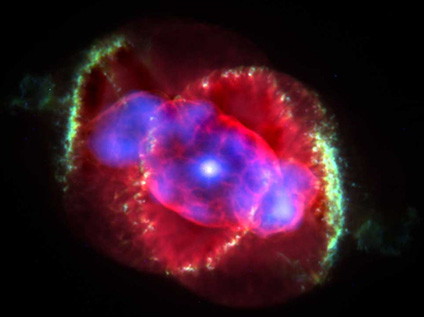
To say that the central star that created the Cats Eye is ancient is an understatement. If it's lucky, it will last a few more million years. And yet it's hard to explain the formation of such a beautiful object without magnetic fields being at play. And when you add the fact that you have strong Xray emissions being picked up by Chandra from the Cats Eye, you have another good case for a strong magnetic field which is known to produce xrays.
After the University of Rochester breakthrough, an international team of astronomers led by Wouter Vlemmings of Leiden Observatory used the United States VLBA (Very Long Baseline Array) of 10 radio telescopes scattered across a distance of 5000 miles to observe 4 old stars for further signs of the Zeeman effect. They found exactly what they were looking for. For the first time the Zeeman effect was detected not only on the surface of the stars but also occurring at a distance from the star as far as twice the distance between the Earth and Pluto. The verdict was finally in. The Zeeman effect is real, differential rotation is real, strong magnetic forces in older stars is real and the wild and varied shapes of planetary nebula are finally explained. Strong magnetic fields are the main determining factor in what final shapes they take.
So you see, Sir Fred Hoyle in his sci-fi book 'The Black Cloud' was right all along. The best way to manipulate a large menacing black nebula in outer space is with a strong magnetic field because that's the way it's done in nature. Science fiction again became science fact.
